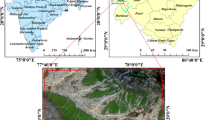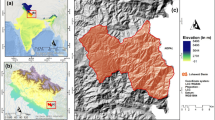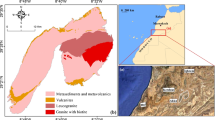Abstract
The German TanDEM-X mission’s primary goal is to create a highly accurate and global digital elevation model (DEM) with global accuracies of at least 10 m absolute height error (linear 90% error). This paper provides one-of-a-kind accuracy assessment of the TanDEM-X global DEM. The assessment of the TanDEM-X DEMs over Nallamala Area, Andhra Pradesh is presented through a comparison with SRTM and TanDEM-X DEMs. TanDEM-X has a finer effective spatial (i.e., horizontal) resolution than SRTM, according to analysis, visualization, and elevation scatterplots. As a first step, digital elevation models are compared to the conventional method of GCP (ground control point) elevation. Then, any two DEMs are compared using a computational method such as R programing, which is a statistical technique that selects point locations with equal distance. TanDEM-X lower elevations indicate that the radar signal penetrates deeper. DEMs with differences allowed the identification of issues related to the production methods of the DEMs. A systematic difference in elevations between TanDEM-X 12 and 30 m, and SRTM was observed. The results show a high level of detail and consistency for TanDEM-X data, indicate that the effective horizontal resolution of SRTM is coarser than the nominal 12 and 30 m. These DEMs are then delineated in QSWAT model for stream network generation. QSWAT is a tool used for the validation of digital elevation models (DEMs) in hydrological modeling. It allows for the comparison of the topographic features of the DEM with field survey data to identify discrepancies and improve model accuracy.























Similar content being viewed by others
Data availability
VRM can provide the data if required
References
Alqahtani F, Qaddah AA (2019) GIS digital mapping of flood hazard in Jeddah-Makkah region from morphometric analysis. Arab J Geosci 12(6):199
Ariza-Villaverde A, Jiménez-Hornero F, De Ravé EG (2015) Influence of DEM resolution on drainage network extraction: a multifractal analysis. Geomorphology 241:243–254
Bolkas D, Fotopoulos G, Braun A, Tziavos IN (2016) Assessing digital elevation model uncertainty using GPS survey data. J Surv Eng 142(3):04016001
Chaubey I, Cotter AS, Costello TA, Soerens TS (2005) Effect of DEM data resolution on SWAT output uncertainty. Hydrol Process 19(3):621–628
Clubb FJ, Mudd SM, Attal M, Milodowski DT, Grieve SWD (2016) The relationship between drainage density, erosion rate, and hilltop curvature: implications for sediment transport processes. J Geophys Res-Earth 121:1724–1745
Datta S, Karmakar S, Mezbahuddin S, Hossain MM, Chaudhary BS, Hoque ME, Abdullah Al Mamun MM, Baul TK (2022) The limits of watershed delineation: implications of different DEMs, DEM resolutions, and area threshold values. Hydrol Res 53(8):1047–1062
Dixon P (2003) VEGAN, a package of R functions for community ecology. J Veg Sci 14(6):927–930
Erdogan S (2010) Modelling the spatial distribution of DEM error with geographically weighted regression: an experimental study. Comput Geo Sci 36:34–43
Garbrecht J, Martz LW (1996) Comment on ‘Digital elevation model grid size, landscape representation, and hydrologic simulations’ by Weihua Zhang and David R. Montgomery Water Resour Res 32(5):1461–1462
Garbrecht J, Starks P (1995) Note on the use of USGS level 1 7.5-minute DEM coverages for landscape drainage analyses. Photogramm Eng Rem S 61(5):519–522
Gautam S, Dahal V, Bhattarai R (2019) Impacts of Dem source, resolution and area threshold values on SWAT generated stream network and streamflow in two distinct Nepalese catchments. Environ Procs 6:597–617. https://doi.org/10.1007/s40710-019-00379-6
Gesch D, Oimoen M, Zhang Z, Meyer D (2012) Validation of the ASTER global digital elevation model version 2 over the conterminous United States. Int Arch Photogramm Remote Sens Spat Inf Sci 39:B4
Hengl T (2006) Finding the right pixel size. Comput Geo Sci 32(9):1283–1298
Horton RE (1945) Erosional development of streams and their drainage basin. Bull Geol Soc Am 56:275–370
Jain K, Ravibabu MV, Shafi JA, Singh SP (2009) Using rational polynomial coefficients (RPC) to generate digital elevation models - a comparative study. Appl GIS 5(2):1–11
Jenson SK, Domingue JO (1988) Extracting topographic structure from digital elevation data for geographic information-system analysis. Photogramm Eng Rem Sens 54(11):1593–1600
Jung C, Ahn S, Sheng Z, Ayana EK, Srinivasan R, Yeganantham D (2022) Evaluate river water salinity in a semi-arid agricultural watershed by coupling ensemble machine learning technique with SWAT model. J Am Water Resour Assoc 58(6):1175–1188
Kayadibi O (2009) Recent advances in satellite technologies using to generate the digital elevation model (DEM), RAST 2009 – Proceedings of 4th International Conference on Recent Advances Space Technologies. 380–385
Kenny F, Matthews B, Todd K (2008) Routing overland flow through sinks and flats in interpolated raster terrain surfaces. Comput Geosci 34(11):1417–1430
Khoi DN, Thomb VT (2015) Parameter uncertainty analysis for simulating stream flow in a river catchment of Vietnam. Glo Ecol Conserv 4:538–548
Kienzle S (2004) The effect of DEM raster resolution on first order, second order and compound terrain derivatives. Trans GIS 8(1):83–111
Lemenkova P (2011) Seagrass mapping and monitoring along the coasts of Crete, Greece. M. Sc.(Master’s) Thesis. University of Twente, Faculty of Earth Observation and Geoinformation (ITC), Enschede, Netherlands, p 158
Lemenkova P (2019) Using R Packages ‘tmap’,’raster’ and ‘ggmap’ for dartographic visualization: an example of DEM-based terrain modelling of Italy, Apennine Peninsula. Zb Rad Geografski fakultet Univerziteta u Beogradu 68:99–116
Lindsay JB (2015) Efficient hybrid breaching-filling sink removal methods for flow path enforcement in digital elevation models. Hydrol Procs 30(6):846–857
Mahmood S, Rahman AU (2019) Flash flood susceptibility modelling using geomorphometric approach in the Ushairy Basin, eastern Hindu Kush. J Earth Syst Sci 128(4):97
Mamillapalli S, Srinivasan R, Arnold JG, Engel BA (1996) Effect of spatial variability on basin scale modeling, in ‘Third International Conference/Workshop on Integrating GIS and Environmental Modeling’. Santa Fe, New Mexico
Meshram SG, Sharma SK (2015) Prioritization of watershed through morphometric parameters: a PCA-based approach. Appl Water Sci 7(3):1505–1519
Moore ID, Grayson RB, Ladson AR (1991) Digital terrain modelling: a review of hydrological, geomorphological, and biological applications. Hydrol Procs 5(1):3–30
Munoth P, Goyal R (2019) Effects of DEM source, spatial resolution and drainage area threshold values on hydrological modeling. Water Res Mangt 33(9):3303–3319. https://doi.org/10.1007/s11269-019-02303-x
Muralikrishnan S, Pillai A, Narender B, Reddy S, Venkataraman VR, Dadhwal VK (2013) Validation of Indian national DEM from Cartosat-1 data. J Indian Soc Remote 41(1):1–13
Nag SK (1998) Morphometric analysis using remote sensing techniques in the Chaka sub-basin, Purulia district. West Bengal J Indian Soc Remote 26(1):69–76
Nagaveni C, Kumar KP, Ravibabu MV (2019) Evaluation of TanDEM-Xx and SRTM DEM on watershed simulated runoff estimation. J Earth Syst Sci 128(1):1–D811
Nuth C, Kääb A (2011) Co-registration and bias corrections of satellite elevation data sets for quantifying glacier thickness change. Cryosphere 5(1):271–290
Olen SM, Bookhagen B, Strecker MR (2016) Role of climate and vegetation density in modulating denudation rates in the Himalaya, Earth Planet. Sci Lett 445:57–67
Pechlivanidis IG, Jackson BM, Mcintyre NR, Wheater HS (2011) Catchment scale hydrological modelling: a review of model types, calibration approaches and uncertainty analysis methods in the context of recent developments in technology and applications. Global Nest J 13(3):193–214
Petroselli A, Alvarez AF (2012) The flat-area issue in digital elevation models and its consequences for rainfall-runoff modeling. GISci Remote Sens 49(5):711–734
R Core Team (2020) R: a language and environment for statistical computing. R Foundation for Statistical Computing, Vienna, Austria
Reddy AS, Reddy MJ (2015) Evaluating the influence of spatial resolutions of DEM on watershed runoff and sediment yield using SWAT. J Earth Syst Sci 124(7):1517–1529
Richardson D, van Oosterom PJM (2002) Advances in spatial data handling. In: 10th International Symposium on Spatial Data Handling. Springer Science & Business Media
Saksena S (2014) (2014) Investigating the role of DEM resolution and accuracy on flood inundation mapping. IGARSS 1:1–119
San BT, Suzen L (2005) Digital Elevation Model (DEM) generation and accuracy assessment from ASTER stereo data. Int J Remot S 26:5013–5027
Sánchez EP, Villarán RF (2012) ‘SRTM 3’ comparison with local information: two examples at national level in Peru. J Appl Geodesy 6(2):75–81
Shafiq M, Irfan M, Khan M (2020) Using multi-mission satellite elevation data for delineation of Gilgit watershed in Pakistan in geographical information technology environment. Int J Econ Env Geol 11(2):19–24
Singh S, Singh MC (1997) Morphometric analysis of Kanhar river basin. Natl Geogrl J India 43(1):31–43
Sowmya DR, Shenoy PD, Venugopal KR (2020) Watershed delineation using SRTM DEM for Bangalore South Region. Int J Eng Sci Invent 9(3):01–09
Strahler AN (1964) Quantitative geomorphology of drainage basin and channel networks, Handbook of applied hydrology. McGraw-Hill, New York (NY), pp 439–476 ISBN:9780071835091
Tribe A (1991) Automated recognition of valley heads from digital elevation models. Earth Surf Proc Land 16(1):33–49
Turcotte R, Fortin JP, Rousseau AN, Massicotte S, Villeneuve JP (2001) Determination of the drainage structure of a watershed using a digital elevation model and a digital river and lake network. J Hydrol 240(3–4):225–242
Waikar ML, Nilawar AP (2014) Morphometric analysis of a drainage basin using geographical information system: a case study. Int J Mul Curr-Res 2(2014):179–184
Wang L, Liu H (2006) An efficient method for identifying and filling surface depressions in digital elevation models for hydrologic analysis and modelling. Int J Geogr Inf Sci 20(2):193–213
Wu M, Shi P, Chen A, Shen C, Wang P (2017) Impacts of DEM resolution and area threshold value uncertainty on the drainage network derived using SWAT. Water 43(3):450–462
Yadav SK, Dubey A, Singh SK, Yadav D (2020) Spatial regionalisation of morphometric characteristics of mini watershed of Northern Foreland of Peninsular India. Arab J Geosci 13(12):1–16
Zhang H, Li Z, Saifullah M, Li Q, Li X (2016) Impact of DEM resolution and spatial scale: analysis of influence factors and parameters on physically based distributed model. Adv Meteorol 10
Zhang J, Chu X (2015) Impact of DEM resolution on puddle characterization: comparison of different surfaces and methods. Water 7(5):2293–2313
Zhang W, Montgomery DR (1994) Digital Elevation Model Grid Size, Landscape Representation, and Hydrologic Simulations. Water Resour Res 30(4):1019–1028
Acknowledgements
The authors would like to thank DLR Germany for providing TanDEMx for research work (Project no. DEM HYDR1630). Also, thanks to anonymous reviewers for their critical reviews and constructive comments.
Author information
Authors and Affiliations
Corresponding author
Ethics declarations
Conflict of interest
The authors declare that they have no competing interests.
Additional information
Responsible Editor: Biswajeet Pradhan
Rights and permissions
Springer Nature or its licensor (e.g. a society or other partner) holds exclusive rights to this article under a publishing agreement with the author(s) or other rightsholder(s); author self-archiving of the accepted manuscript version of this article is solely governed by the terms of such publishing agreement and applicable law.
About this article
Cite this article
Chokkavarapu, N., Mandla, V.R., Peddinti, V.S.S. et al. Linear aspects of morphometric analysis generated from QSWAT: with special reference to accuracy of various DEMs with conventional and computation techniques. Arab J Geosci 16, 582 (2023). https://doi.org/10.1007/s12517-023-11700-x
Received:
Accepted:
Published:
DOI: https://doi.org/10.1007/s12517-023-11700-x




